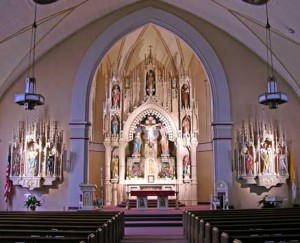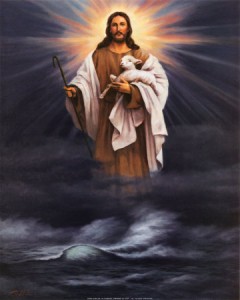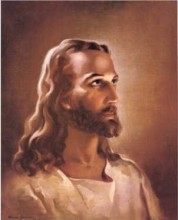The Catholic Church

The Catholic church

The Catholic church
The Church: Founded by Jesus Christ
The whole life of Jesus, the Word made flesh, was the foundation for the Church.
Jesus gathered to himself followers who committed themselves completely to himself. Praying before hand. Jesus then close his inner circle – The Twelve , To twelve he disclosed personal knowledge of himself, spoke of his coming passion and death and gave in depth instruction regarding what following his way entailed. Only twelve were allowed to celebrate his last super with him.
The twelve were called apostles – that is, emissaries whose mission was to be Jesus’ personal representatives. He gave these apostles the full power of authority he had from the father. The fullness of that authority is indicated in words of Gospel; “Truly, I say to you, whatever you bind on earth shall be found in heaven, and what ever you loose on earth on shall be loosed in heaven†(Mt 18:18).
The climax of Jesus’ preparation for the Church was the Last Supper. At this meal he took bread and wine said; “Take and eat, this my body; take and drink this is my blood.†with these words he actually gave himself to them. Receiving him in this way, the Twelve entered into a union of such total intimacy with him and with one another that nothing like it had ever before take place. At that meal they became one body in Jesus. That the early Church understood the depth of the communion is shown in the earliest, the words of Saint Paul: “Because there is one bread, “we who are many are one body, for we all partake of one bread†(1 Cor 10:17).
At the super, Jesus also spoke of the “new testament,†God was establishing a new relationship with humankind, a covenant sealed with the sacrificial blood of Christ himself. This new relationship was to be governed by anew Law: the commandment of love.
The earliest account of the Eucharist, Corinthians, reveals what the Last super meant for the future of Church. Jesus is recorded as saying, “Do this remembrance of me†(1 Cor 11:24). Jesus fore saw a long time in which is presence would not be visible to his followers. He intended that the Church repeat this super again and again during that time. In this memorials, he would be intimately present, that risen Lord of history leading his people towards that future day when he will “make all things new,†the day when there will be “ a new heaven and a new earth†(Revelation 21:1. 5).
The Last super was Jesus “final step, before his death. In preparing the Twelve this celebration revealed how they, and their successors through the ages, were to carry out his mission of teaching, sanctifying and governing.
According to the Gospels (Mt 16:13-19), (Lk 22:31f), (Jn 21:15-17), the responsibility given to apostles was given in a special way to Saint Peter. In the Gospels of Mathew Jesus’ words are ; And I tell you, you are peter, and on this rock I will build my Church, and the powers of death shall not prevail against it ,â€peter is to be the rock, the visible representatives of Jesus who is foundation of the church Peter is to provide the Church with unshakable leadership against “the powers of death,†any forces that would destroy what Jesus brings to his people.
Jesus founding of the church was completed with the sending of the Holy Spirit. The actual birth of Church took place on the day of Pentecost. This sending of the Spirit took place publicity, just as the crucifixion of Jesus took place in public view, Ever since that day, the Church has shown itself to be a divine human reality – a combination of the spirit working and the people striving, in their human way, to cooperate with the gift of his the presence and Christ’s Gospel.
The Church as the Body of Christ
The image of the Church as the body of Christ is found in the New Testament Writings of Saint Paul. In Chapter 10 of 1 Corinthians, Paul says that our communion with Christ comes from “the cup of blessing†which unites us in his blood and from “the bread which we break†which unites us to his body. Because the bread is one, all of us,, though many , are one body. The Eucharistic body of Christ and the Church are, together, the (mystical) Body of Christ.
In chapter 12 of 1 Corinthians (and in chapter 12 of Romans), Paul emphasizes the mutual dependence and concern we have as members of one another. In the letters to the Ephesians and Colossians, the Emphasis is on Christ as our head. God gave Christ to the Church as its head. Through Christ, God is unfolding ‘his plan, “the mystery hidden for ages,†to unite all things and to reconcile us to himself. Because this mystery is being unfolded in the Church, Ephesians calls Church the mystery of Christ.
The Church as the Sacrament of Christ
In our own time, Pope Paul VI has expressed the same truth with these words: “The Church is mystery. It is a reality imbued with the hidden presence of God.â€
When Saint Paul and Pope Paul call the Church a mystery, the word has the same meaning as the word sacrament. It means a visible sign of God’s invisible presence.
Just as Christ is the sacrament of God, the church is your sacrament of God, your visible sign, of Christ. But the church is not a sacrament for members only, “In its Constitution on the church, the second Vatican Council clearly says; “By her relationship with Christ, the Church is kind of sacrament or sign of intimate union with God, and of the unity of all mankind. She is also an instrument for the achievement of such union and unity†(The Church, 1).
In the plan that God has for the human race, the Church is the sacrament, the primary visible instrument through which the spirit is bringing about the total oneness that lies in for us all.
The process of salvation, however, is a divine – human venture. We all in have a part in it. Our cooperation with the spirit consist of becoming a Church that so sees Christ in others that others see Christ in us.
The Catholic People God
In speaking of the church, the second Vatican council emphasizes the image of the people of God more than any other one.
Strictly speaking, all people are the people of God; in chapters 8 and 9 of Genesis, the bible testifies that God has a convent relationship with all of humankind. But the people of God image apply in a special way to Christ’s New Testaments followers, and sheds light on important features of the Catholic community.
One important fact about Catholics is this; we have a sense of being a people,. Even though we are made up of the most varied ethnic and national groups, we have a sense of belonging to the sane world-wide family.
Another thing about the Catholic people is our sense of history. Our Family lines reaches back to earliest Christianity, Few of us know the whole panorama of our history as a Church. But most of us know stories of martyrs and Saints. We know of groups, ancient and modern, who have endured persecution for the faith. And deep down we identify with these people and their history. All those generations who went before us are your people and mine.
Our sense of being a people goes very deep. There may be lapsed Catholics and non practicing Catholics. But good or bad, they are Catholics, when they want to come back, they know where home is. And when they do come home, they are welcomed. The Church has its imperfections. But at its heart is the endless steam of God’s mercy and forgiveness.
The Catholic community is not the whole of God’s people. But it is those strong, identifiable core groups who realize were we are all going. Like the Old Testament people trudging toward the promised Land, we are keenly aware that “hear we have no lasting city, but we seek the city which is to come†(Heb 13:14 ) Our faith instinct tell us that God is in our feature, and that one we need another to reach him. That is part of our strength, a facet of our mystery.
The Catholic Church: a unique Institution
In the 16th Century Cardinal Robert Bellarmine wrote: “The one and true Church is the community of men brought together by the profession of the same sacraments, under the Government of the legitimate pastors and especially the one vicar of Christ on earth, The Roman Pontiff.â€
As a definition of the Church the Bellarmine statement is incomplete; it speaks of the church only as a visible institution. A more complete definition would note, as a Pope Paul VI has done, that the Church is a mystery …imbued with the hidden presence of God.†But the Bellarmine definition lays stress on an important point: The Church is visible social reality; it has an institutional side to its makeup. From the earliest years of its history, Christianity has had a visible structure: appointed leaders, prescribed forms of worship, and approved formulas of faith. Seen in terms of these elements the Catholic Church is visible society. Because it is also mystery, however the church is unlike any other organized group.
As a visible society, the Catholic Church is unique. Other Christian Churches posses some very basic “elements†in common with it, such as “one Lord on Faith , one baptism, one God and Father of us all†(Eph 4:5) But as Vatican II Points out, “These elements as gifts properly belonging to the Church of Christ , posses and inner dynamism toward Catholic unity†( The Church, 8).
Further more – and this is a decisive point regarding the uniqueness of the Catholic Church – Vatican II states that “This Church constituted and organized in the world as a society, subsists in the Catholic Church…†(The Church, 8). This key statement teaches that the basic fullness of the Church, the vital source of complete Christian unity in the future is foun uniquely in the visible Catholic Church.
Infallibility in the Church
Christ gave to the Church the task of proclaiming his Good News (Mt 28:19-20). He also promised as his spirit. Who guides us “into the truth†(Jn 16:13). That mandate and that promises guarantee that we, The Church, will never fall away from Christ’s Teaching. This inability of the Church as a whole to stray in to error regarding basic matters of Christ’s teaching is called infallibility.
The Pope’s responsibility is to preserve and nourish the Church. This means Striving to realize Christ Last supper prayer to his father, That they may all be one ; even thou, Father, art in me and I in thee, that they also may be one in us , so that the world may believe that thou has sent meâ€(Jn 17:21).
Church Teaching has a sacramental side to it; it is meant to be a sign and instrument of unity. Because the Pope’s responsibility also to be a sacramental source of unity, he has a special role in regard to the Church’s infallibility.
The Church’s sacramental infallibility is preserved by its key instrument of infallibility. The Pope, The infallibility which the whole Church has belongs to the Pope in a special way. The spirit of truth guarantees that when the Pope declares that he is teaching infallibly as Christ’s representative and visible head of the Church on basic matters of faith or morals, he cannot lead the Church into error. This gift from the spirit is called papal infallibility.
Speaking of the infallibility of the Church, the Pope, and the Bishops, Vatican Council II says:â€This infallibility with which the divine Redeemer willed his Church to be endowed…is the infallibility which the Roman Pontiff, the head of the college of bishops, enjoys in virtue of his office…. The infallibility promised to the Church resides also in the body of bishops when that body exercises’ supreme teaching authority with the successor of peter†(The Church, 25).


